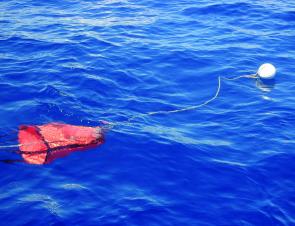A lot of boats anchor around the reefs. The plan is logical: Set anchor up current from fish you’ve found on the sounder, then get a berley trail going and encourage the fish to hang around you. There is no doubt this technique produces results, however, many lure anglers prefer an alternative – the drift.
I’ve always preferred drifting as it allows me to cover a lot of ground in search of big fish – I also don’t have to contend with getting tangled in the anchor rope once I hook up that XOS screamer. As I like to drift slowly, I have found that the humble sea anchor is a necessity I can’t live without.
Also known as a drogue, drift sock, or parachute, the sea anchor reduces wind drift by creating extra drag in the water. It can also be used to change the angle of the boat’s drift so that you can fish a maximum number of lines out of the boat at the best angle.
A boat’s sea anchor set up is unique to that boat and a wide range of size options exist. As a rule, the bigger the boat the bigger the drag, so the bigger the sea anchor. Most sea anchors come with a boat size recommendation that I find pretty accurate, or alternative try one size larger.
The secret to trouble free sea anchoring is all in the set up. There are a few set up options, but here is my preferred arrangement for trailer boats.
Tie a rope to the front of the sea anchor so that the ‘sock’ sits about halfway down the length of the boat. This rope will be tight when the sea anchor is deployed in the water, which is attached to a bow cleat on the boat.
Next run a rope, known as a trip line, to the back of the sea anchor. The trip line, when cleated off, should have some extra length in it (slack) when the sea anchor is deployed. This line will enable you to pull the sea anchor in backwards with ease, as when you pull it in all the water flows out so your don’t have to pull a huge dead weight full of water.
The trip line can be tied off to a variety of options, including the same bow cleat as the ‘tight’ rope, or it can be tied off to the side of the cabin to allow easy reach. I tend to tie the trip rope to the bow cleat as this allows me to use one continuous rope as the tight rope and the trip rope.
The important factor is to ensure that you tie the tight rope shorter than the trip rope and that you always have slack in your trip rope. Once you get it right, put a marker on the rope and tie it off at the same spot every time.
The third, and final, rope is a trailing rope and should be tied to a float at the tail end of the sock. This float also helps pull the sea anchor in.
You can use one rope for all three jobs – just tie it in the appropriate places.
Deploying the sea anchor is a simple matter of lowering it all over the side (float first) so that it doesn’t tangle up.
When retrieving the sea anchor, fire up the engine and nudge the boat ahead. This brings the sea anchor alongside the hull and you can lean over and pick up the float or the trailing line and pull the sea anchor in backwards.
A tweak to your system is to have the float tied in a little loop that fits over your rear cleat (or into your hawse) so that you can hold the sea anchor and its lines in place while you are travelling back to your next drift.
It doesn’t hurt to use fairleads to tweak the angle of drag to adjust the angle of the boat’s drift for maximum spread of fishing lines. You can also use the engine(s) or rudder(s), by turning it full right, full left, or somewhere in between in order to fine-tune the drift angle.
If you have a large boat, you may not want to run the ropes too long. If you can pick up the rope by being able to get a crew member with a boat hook down the side of the boat or even the bow as you nudge ahead in gear then shorter ropes will work better. The same goes for walkaround styles and centre consoles. The shorter the rope the less hassle it will give you when you are fighting and landing fish.
Over the years, I’ve used a few different sea anchors and some are harder to use than others. However, when it is easy to use you’ll use it all the time, and you’ll catch more fish because of it. Sea anchors allow you to drift slower, so you can use less weight on your line and therefore your baits freefall slower.
Reads: 29643
Using a sea anchor helps to slow you down when drifting. Note the ropes: tight rope, the trip rope and the trailing rope that goes to the float.

The trailing line and the float that is on a loop to enable it to be dropped over a cleat.

When drifting livebaits through schools of seriolas, such as this yellowtail kingfish, the slower drift allows your baits to stay in the strike zone for longer.

Using a sea anchor and casting soft plastics ahead of the drift allows your soft plastic to get down to the suspended fish, like this squire, and stay there with less weight. A slower freefall, and the lure’s ability to waft in the strike zone, often mean




